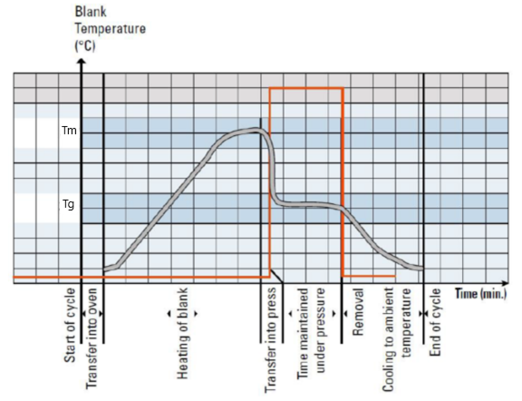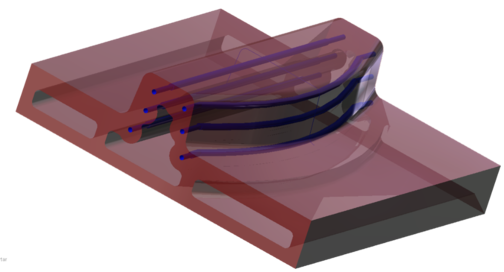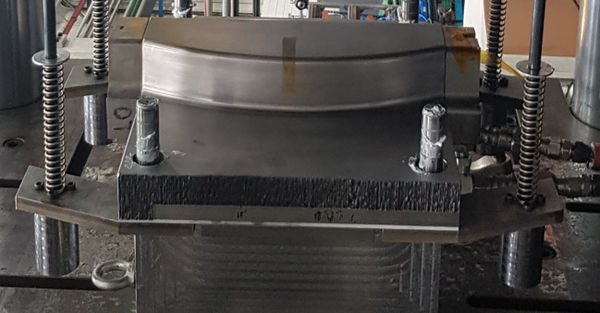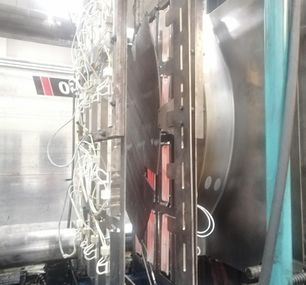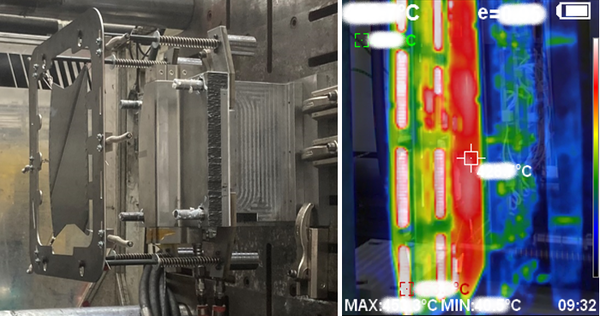Introduction
Composite materials have become one of the pillars of today's aeronautics industry. It could be verified the use of composite materials on aviation since first flight of the Wright Brothers’ Flyer 1 on December 17, 1903, nevertheless, it was not until 1960 that these materials began to be definitively integrated into the industry [1]. Airbus used for the first-time composite materials on the vertical stabilizer of the A300 aircraft more than 50 years ago, and nowadays the A350 model use lightweight composite materials on critical structural components [2]. This significant increase in the use of composite materials not only leads to further research into the uses of these materials, but also to the development of manufacturing techniques for parts made from them.
Nowadays, thermosetting composites, based on carbon fibre high-performance reinforcements held together by polymer resin, are the most common composite materials used in the aircraft industry [3]. Despite their superior characteristics compare to metallic materials (superior specific strength and stiffness, along with improved corrosion and fatigue resistance) [4], the development of new thermoplastic composite materials will lead to their substitution in future applications. Thermoplastic composite materials present similar mechanical properties than thermoset materials [5]–[7], however, their its advantages in terms of energy and process time savings during manufacture, its recyclability and reusability [8] position thermoplastic composites as a promising alternative to thermoset materials.
It should be noted that most of these composite materials are not final products, but rather intermediate products that are converted into final products by advanced manufacturing methods. This is the case, for example, of 3D printing [9] or press-forming processes [10].
Regarding the press-forming process, which will be the one developed in the article, is based on the following steps and summarize at Figure 1:
- 1. A consolidated rCF thermoplastic composite plate is positioned on the press-forming system.
- 2. The plate is heated up until it reaches its processing temperature (Tm), also called melt temperature. At this temperature, the thermoplastic matrix is fluid enough to adapt to the mould’s final geometry.
- 3. Once this temperature is reached, the composite plate is placed on the press-forming mould (already heated). At this point, the system rapidly closes, exerting high pressure to the composite plate.
- 4. After the mould closing and stabilization cycle, the cooling system starts decreasing the temperature of the whole. The system should reach a temperature lower than the material glass transition temperature (Tg). At this temperature the polymer that makes up the composite undergoes a transition from rubbery state to glassy state.
- 5. At this point, the final conformed part is ready to be extracted from the system.
Regarding the explained press-forming process, the performing toolings function conceptually as a mould. In terms of this mould manufacturing, concepts such as thermal expansion or spring-back [11] are taken into consideration during the design stage. In addition, the mould will be heated by means of thermal oil (a fluid capable of reaching high temperatures), which will run through the mould via channels designed for this purpose. This channels optimization should theoretically be adapted to the surfaces of the final geometry, so that the temperature behaves homogeneously throughout the part. This objective is hard to achieve during tooling manufacture process using traditional methods, due to system restrictions. However, new manufacturing models, such as Additive Manufacturing (AM), propose novel solutions to this problem. For this reason and taking into account other properties of the AM processes such as possible energy and material savings, the core of the forming tool was manufactured by metal additive manufacturing (MAM).
The MAM technology chosen was Wire Arc Additive Manufacturing (WAAM), which is a fusion AM process in which the heat energy of an electric arc is employed for melting the electrodes and depositing material layers for wall formation or for simultaneously cladding two materials to form a composite structure [12]. This technology allows the creation of large metallic toolings following geometries impossible to achieve by conventional manufacturing methods. Moreover, due to the large size of the tooling manufactured, this construction would be considered as a Big Area Additive Manufacturing (BAAM) product [13]. Based on the data obtained from the tooling manufacturing and performance, not only the press-forming process would be tested, but the availability of an AM tooling to carry out this process.
This article looks forward to describing an experimental thermoplastic composite material forming process, performed by a mould partly made by additive manufacturing (tie part). The aim of the article is not only validating the press-forming manufacturing process for the rCF thermoplastic material tested, but the operability of a tooling made by WAAM technology.
Methods/Case study
All test performed for this article were made under INNOTOOL project [14], on Clean Sky 2 program, within the Horizon 2020 framework, whose objective is the development of a rCF thermoplastic press-forming tool for advanced rear end closing frame prototype. The rCF thermoplastic material used was LM PAEK reinforced by carbon fibre with quasi-tropical disposition (45º/135º/90º/0º). Should be mentioned that the significant thickness of this part was one of the critical points of the process. As aforementioned, both the press-forming manufacturing process and the WAAM tooling performance would be tested. Moreover, 2 symmetrical toolings were required for this project, allowing the comparison of material and energy consumption between the core produced by WAAM process and the symmetrical one produced by conventional machining.
This article would be divided in 2 differentiated parts:
- AM tooling description, encompassing its design and manufacturing processes.
- Press-forming process description and performance
It should be mentioned that both the material and the press-moulding process have been tested experimentally beforehand. Therefore, the scaling of the system has been done based on the results obtained in these tests.
AM tooling
As mentioned, press-forming tooling designed concept could be assimilated to that of a mould. For this project, only the die part of the mould was performed by WAAM, therefore, this article would focus on this WAAM tooling core. Should be highlighted that, as WAAM process is based on the superposition of material layers, the final printed geometry shows an uneven finish. For this reason, WAAM technology is consider a Near-to-Net-Shape technology, which requires from a second-stage machining process before being considered finalised [15], [16]. This second-stage machining will be also measured, and the results will be presented. Should be mentioned that the selected wire material was ER70S-6 (carbon steel electrode), and the shield gas was SANARC 8 (CO2 8% Ar 92%).
Regarding the WAAM core design, thanks to the design possibilities of the technology, several optimizations could be performed compared to the symmetrical core manufactured by conventional methods, emphasizing the following two:
- Internal heating channels could be directly performed adapting to the final geometry.
- Tooling inner part was designed empty in order to reduce tooling weight and therefore, thermal inertia.
Figure 2 displays inner channels disposition, highlighted in blue.
Across both the WAAM process and second-stage machining process, material and energy consumption were analysed. Also, the symmetrical tooling conventional machining manufacturing process was analysed, allowing a direct comparison of the above-mentioned consumptions, as well the total time of the processes.
The results show an important reduction in terms of energy consumption, being the amount of energy needed for the 2 combined manufacturing processes (WAAM process + Second-stage machining) 20% lower than the single process traditional manufacturing. Also, tooling weight is 40% reduced. Regarding the material save, this reduction is even much favourable, decreasing the amount of material consumed by 40%. Nevertheless, the WAAM manufacturing process carries an important increase in total process time, being the total process time 4 times longer than in the case of tooling made by conventional methods.
Press-forming process
The aforementioned explained press-forming system was adapted to the dimensions and characteristics of an injection machine (Billion 750) in such a way as to take advantage of both its closing speed and operating pressure. The clamping force of the press was set at 300 tonnes, affecting the surface of the rCF thermoplastic material by approximately 100 bar thanks to the compression stops designed for the tooling.
Regarding the thermal cycle, material Tm is in the range of 400 ºC, which is a thermal requirement that is difficult to achieve with conventional heating systems such as electric heaters or thermal oil. For this reason, infrared radiation heating was chosen. Infrared radiation heating system was based on 2 lamp grills filled by infrared radiation screens (Figure 4). These screens are medium-wave emitters that allow the transfer of thermal energy from one body to another without the need for any intermediate support and without the sensitive absorption of the energy emitted by the medium that separates them, which is usually air. Should be mentioned that the lamp grill system was designed to ensure that it could be rapidly removed from the press during the process. The temperature must be controlled during this thermal process, as an unbridled temperature rise could degrade the material.
It should be noted that the rCF thermoplastic plate was adapted in geometry to the subsequent process devised, for this reason, areas with different amounts of extra material were designed. This material was used both as a clamping area for the thermoplastic plate and as a back-up material to ensure that, after a trimming process, the final part complies with the required dimensions.
Regarding the moulding system, process temperature requirement is less restricted, requiring process temperatures slightly superior to the LM PAEK Tg, around 200 ºC. This temperature is achievable by an industrial oil heating system, which performs not only heating cycle, but also the cooling cycle.
The rCF thermoplastic part press-forming process, based on the explained cycle at Introduction section, is broken down as follows:
- 1. The WAAM mould oil heating system is initiated, heating up the mould until a temperature superior to thermoplastic Tg. This process would last between 3 to 4 hours.
- 2. The consolidated rCF thermoplastic plate is placed on the positioning framework. This framework is developed to allow the IR heating while positioning the plate. Its design also allows the plate to be strategically clamped, maintaining the necessary traction in critical areas across the process.
- 3. The positioning framework is placed at the press-moulding tooling, where it is heated up by the aforementioned IR lamp grills until the Tm is reached. IR heating is shown at Figure 5. This IR heating process is relatively fast regarding the high temperatures achieves, lasting approximately 30 min.
- 4. At this point, the IR lamp grill is removed, allowing the press-moulding system to close. Taking advance of the injection mould system, a rapid confinement of the rCF thermoplastic plate is achieved in seconds.
- 5. The moulding system pressure is maintained until the conformed rCF thermoplastic part is stabilized, ensuring the whole part maintains a homogeneous temperature. This process takes around 20 min. After this stabilization time, cooling system refrigerates the whole tooling.
- 6. When the temperature of the system decreases below the Tg, the mould opens, and the conformed part is retrieved. This cooling process last around 2 hours.
The rCF thermoplastic part obtained from this process was subjected to a trimming post-process, using a positioning and cutting tooling for this purpose. After this process, the part was subjected to a metrological studio (Figure 6). It should be noted that the tolerances of this part, being a first R&D process in development, are not very restrictive, being ±2 mm in these first tests.
Results/Conclusions
As stated in the Introduction section, the objective of this study is the validation of both the AM process for mould manufacture and the press-forming process for the manufacture of CFRP parts. This combination of process aims not only to perform the forming process of large rCF thermoplastic materials quickly, but also to take advantage of the possibilities of AM process to produce complex structures in order to accelerate manufacturing cycles.
Regarding to the additive process (WAAM), the optimisation of the mould allows significant energy and material savings compared to conventional production. Moreover, in direct process terms, the possibility of adapting the thermal heating channels to the geometry of the part and the reduction in the mass of the tooling reduces the thermal cycle time, and, thus, the production cycle. It is important to note that the optimisation of tooling manufacturing by additive manufacturing is directly dependent on the geometry of the final tooling, so the data cannot be extrapolated as valid for any design, but nevertheless show a very favourable trend for AM processes based on WAAM technology. For these reasons, this study verifies this process as suitable for a press-moulding process with rCF thermoplastic materials.
Also, thanks to the core mould weight reduction achieved by the WAAM process, thermal inertia was reduced. This optimisation can be seen in the cycle times, which are reduced by 20% compared to those measured with conventional manufacturing made mould. However, it is estimated that the manufacture of the female mould using the WAAM process would be able to further optimise cycle times. This solution will be evaluated for future applications.
As for the press-moulding process for rCF thermoplastic parts, several innovations were incorporated. Firstly, the design and cutting of the CFRP fabric was optimised to fit correctly on the tooling. Also, the IR lamp grill system was designed as a removable tooling, which can be taken out of the press station during the process, avoiding the need to transport the CFRP plate from the infrared heating station to the press station. This feature prevents the heat loss that this entails. Finally, Process parameters obtained from previous tests and subsequently scaled for this study proved to be valid in view of the results.
On the other hand, it should be noted that the accuracies achieved, despite being within the framework of validity of the project as it is an R&D process, are much higher than those commonly used in the aeronautical industry. In this direction, studies on the thermal shrinkage and spring-back processes of the part should be carried out.
Acknowledgment
Author Contributions: All co-authors have covered all tasks of this research.
Funding: The authors gratefully acknowledge the European commission for support through the financial aid under the framework HORIZON-CL4-2021-TWIN-TRANSITION-01- 5 program through the project BIO-UPTAKE (PN:101057049 DOI: 10.3030/101057049) This study has been performed by members of the I+AITIIP (DGAT08 23R) research group recognised by the Administration of the Community of Aragon for the period 2023-2025 (Order CUS/1638/2022, of 8 November).
Conflicts of Interest: The authors declare no conflict of interest.
Bibliography
[1] C. Soutis, “Fibre reinforced composites in aircraft construction,” Progress in Aerospace Sciences, vol. 41, no. 2, pp. 143–151, Feb. 2005, doi: 10.1016/J.PAEROSCI.2005.02.004.
[2] O. Memon, “How Composite Materials Make The Airbus A350 A Gamechanger,” Simply Flying, Jan. 04, 2023. https://simpleflying.com/composite-materials-airbus-a350-gamechanger/ (accessed Jan. 30, 2023).
[3] C. Soutis, “Carbon fiber reinforced plastics in aircraft construction,” Materials Science and Engineering: A, vol. 412, no. 1–2, pp. 171–176, Dec. 2005, doi: 10.1016/j.msea.2005.08.064.
[4] B. G. Falzon and R. S. Pierce, “Thermosetting Composite Materials in Aerostructures,” in Revolutionizing Aircraft Materials and Processes, Cham: Springer International Publishing, 2020, pp. 57–86. doi: 10.1007/978-3-030-35346-9_3.
[5] A. Sudhin, M. Remanan, G. Ajeesh, and K. Jayanarayanan, “Comparison of Properties of Carbon Fiber Reinforced Thermoplastic and Thermosetting Composites for Aerospace Applications,” Mater Today Proc, vol. 24, pp. 453–462, 2020, doi: 10.1016/j.matpr.2020.04.297.
[6] T. Gobikannan et al., “Flexural properties and failure mechanisms of infusible thermoplastic- and thermosetting based composite materials for marine applications,” Compos Struct, vol. 273, p. 114276, Oct. 2021, doi: 10.1016/j.compstruct.2021.114276.
[7] R. E. Murray et al., “Structural validation of a thermoplastic composite wind turbine blade with comparison to a thermoset composite blade,” Renew Energy, vol. 164, pp. 1100–1107, Feb. 2021, doi: 10.1016/j.renene.2020.10.040.
[8] W. S. Khan, E. Asmatulu, Md. N. Uddin, and R. Asmatulu, “Recycling and reusing of thermoplastic and thermoset composites,” in Recycling and Reusing of Engineering Materials, Elsevier, 2022, pp. 141–161. doi: 10.1016/B978-0-12-822461-8.00001-2.
[9] B. Barış Vatandaş et al., “Additive manufacturing of PEEK-based continuous fiber reinforced thermoplastic composites with high mechanical properties,” Compos Part A Appl Sci Manuf, vol. 167, p. 107434, Apr. 2023, doi: 10.1016/J.COMPOSITESA.2023.107434.
[10] D. Tatsuno, T. Yoneyama, K. Kawamoto, and M. Okamoto, “Hot press forming of thermoplastic CFRP sheets,” Procedia Manuf, vol. 15, pp. 1730–1737, Jan. 2018, doi: 10.1016/J.PROMFG.2018.07.254.
[11] M. J. Donough, Shafaq, N. A. St John, A. W. Philips, and B. Gangadhara Prusty, “Process modelling of In-situ consolidated thermoplastic composite by automated fibre placement – A review,” Compos Part A Appl Sci Manuf, vol. 163, p. 107179, Dec. 2022, doi: 10.1016/J.COMPOSITESA.2022.107179.
[12] M. Chaturvedi, E. Scutelnicu, C. C. Rusu, L. R. Mistodie, D. Mihailescu, and S. A. Vendan, “Wire arc additive manufacturing: Review on recent findings and challenges in industrial applications and materials characterization,” Metals (Basel), vol. 11, no. 6, 2021, doi: 10.3390/met11060939.
[13] A. Roschli et al., “Designing for Big Area Additive Manufacturing,” Addit Manuf, vol. 25, 2019, doi: 10.1016/j.addma.2018.11.006.
[14] AITIIP FUNDATION, “Hybrid automated machine integrating concurrent manufacturing processes, increasing the production volume of functional on-demand using high multi-material deposition rates Fact Sheet Project Information.” 2019. doi: 10.3030/723759.
[15] R. Warsi, K. H. Kazmi, and M. Chandra, “Mechanical properties of wire and arc additive manufactured component deposited by a CNC controlled GMAW,” Mater Today Proc, vol. 56, pp. 2818–2825, Jan. 2022, doi: 10.1016/J.MATPR.2021.10.114.
[16] N. Chernovol, A. Sharma, T. Tjahjowidodo, B. Lauwers, and P. Van Rymenant, “Machinability of wire and arc additive manufactured components,” CIRP J Manuf Sci Technol, vol. 35, 2021, doi: 10.1016/j.cirpj.2021.06.022.
Document information
Published on 25/09/24
Accepted on 31/03/24
Submitted on 14/05/23
Volume 08 - COMUNICACIONES MATCOMP21 (2022) Y MATCOMP23 (2023), Issue Núm. 6 - Fabricación y Aplicaciones Industriales, 2024
DOI: 10.23967/r.matcomp.2024.06.01
Licence: Other
